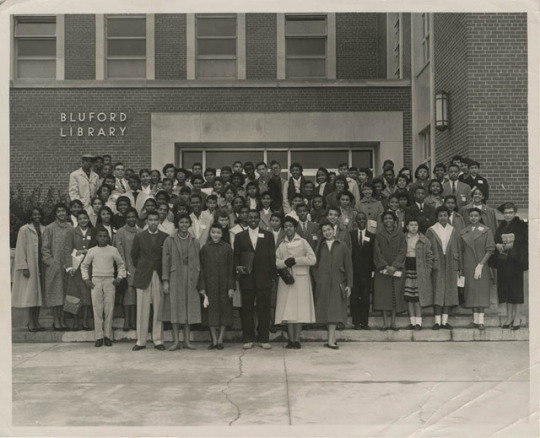#North Carolina Agricultural and Technical State University
Text

F. W. Woolworth's Building; International Civil Rights Center & Museum
Surfing around I saw this photo out of the corner of my eye. I knew exactly where it was taken and its significance. I was kinda shocked.
The photo link is to a page at The Civil Rights Trail, The Civil Rights Center and Museum are in Greensboro. There's a short video of Robert Petterson talking about the lunch counter sit-ins in 1960. Four freshmen students at North Carolina Agricultural and Technical State University--Aggies--led the demostrations: and became known at the Greensboro Four : David Richmond, Franklin McCain, Ezell A. Blair, Jr., and Joseph McNeil.
I was pretty little in 1960, I am not even sure we had a televison set at home. That those stools at Woolworth"s are so iconic to me shows how powerful the movement of sit-ins were. Certainly I'm old enough to remember racist segregation. The thousands of young people who participated in sit-ins inspired me as a lad. I knew they were creating something good. At least trying to make living better for all of us.
9 notes
·
View notes
Text

The 1969 Greensboro uprising occurred on and around the campuses of James B. Dudley High School and North Carolina Agricultural and Technical State University when, from May 21 to May 25, gunfire was exchanged between student protesters, police, and the National Guard. One bystander, sophomore honors student Willie Grimes, was killed, although whether he was killed by police or protesters remains unknown.
The uprising was sparked by perceived civil rights issues at the segregated high school when a popular student council write-in presidential candidate was denied his landslide victory allegedly because school officials feared his activism in the Black Power movement. Starting on the campus of Dudley High School, the uprising spread to the A&T campus where students had stood up in support of the Dudley protest. Escalating violence led to armed confrontation and the invasion of the A&T campus by what was described at the time as “the most massive armed assault ever made against an American university”. The uprising ended soon after the National Guard made a sweep of A&T college dormitories, taking hundreds of students into protective custody.
While local officials blamed outside agitators, a report released by the North Carolina State Advisory Committee to the Commission on Civil Rights found that James B. Dudley High School had an unjust system and suppressed dissent. They found the National Guard invasion reckless and disproportionate to the actual danger and criticized local community leaders for failing to help the Dudley High School students when the issues first emerged. They declared it “a sad commentary that the only group in the community who would take the Dudley students seriously were the students at A&T State University.”
2008 saw the release of a documentary recounting the event, Walls that Bleed. #africanhistory365 #africanexcellence
1 note
·
View note
Text
SAS & NC Universities Launch Innovative Research Collaboration
Key Takeaways
Enhanced Agricultural Research: The partnership between North Carolina Agricultural and Technical State University, North Carolina State University, and SAS aims to advance agricultural research through cutting-edge technology.
Focus on Precision Agriculture: This collaboration will boost efforts in precision agriculture, supporting continuous advancements in plant sciences, animal…

View On WordPress
0 notes
Text
Gregg A. Lowe: Shaping Tomorrow’s Semiconductor Industry withPioneering Silicon Carbide Solutions

In a seminal shift for the semiconductor industry, a technological revolution is unfolding, challenging the long-standing dominance of silicon. Governments worldwide, driven by a surge in clean energy standards, are spearheading the transition from traditional silicon to the more efficient silicon carbide. With a 10-15% energy efficiency boost, silicon carbide becomes
indispensable in high-power applications, potentially reshaping energy consumption globally. At the forefront of this transformation stands Gregg A. Lowe, CEO of leading silicon carbide company, Wolfspeed. As a global leader, Wolfspeed contributes over 60% of the world’s silicon carbide and is strategically investing in its future.
Lowe spearheads innovations that are driving a monumental shift in the semiconductor world. The journey of Wolfspeed, formerly known as Cree, reflects a commitment to harnessing the potential of SiC, a superior semiconductor material. Lowe’s leadership has been pivotal in positioning Wolfspeed as a pure-play SiC semiconductor powerhouse, leading the worldwide
transition from silicon to Silicon Carbide.
Wolfspeed: Pioneering the Silicon Carbide Revolution
‘Wolfspeed’s strategic shift to SiC semiconductor production aligns with the industry’s demand, steering a sustainable, energy-efficient future’ – Gregg A. Lowe
Founded in 1987 at North Carolina State University, Wolfspeed was born out of a vision held by a group of dedicated graduate students who recognised the unparalleled potential of Silicon Carbide. The recent rebranding from Cree to Wolfspeed signifies a strategic focus on being a leading force in SiC semiconductor technology. Silicon Carbide, a material that has revolutionised the semiconductor industry, finds applications in various sectors, from wireless infrastructure and renewable energy to aerospace and defence.
Wolfspeed’s product portfolio is at the forefront of innovation, offering disruptive technology solutions for a more efficient and sustainable future. Gregg Lowe provides insights into Wolfspeed’s trajectory, highlighting the pivotal role SiC plays in advancing industries such as electric vehicles, fast charging, 5G, and power supplies. The semiconductor company’s commitment extends beyond personal vehicles to complete electrification, encompassing freight, trucking, mass transportation, and more.
Strategic Leadership: Gregg Lowe’s Vision for Wolfspeed
Gregg Lowe’s leadership at Wolfspeed is characterised by a strategic focus on expanding the business while exploring strategic alternatives. Recognising Silicon Carbide’s potential for electric vehicles, 5G, renewables, and various industrial applications, Lowe initiated a significant increase in Silicon Carbide production. The establishment of the “Silicon Carbide corridor” on the East Coast, anchored by manufacturing facilities in North Carolina and New York, underscores the company’s commitment to being a pure-play semiconductor powerhouse.
Lowe’s tenure has seen Wolfspeed evolve into a company that applies its history of innovation across all facets of its operations. The commitment to creating a great place to work is reflected in the company’s culture, fostering diversity, equity, and inclusion. Initiatives such as increased pay, flexible work arrangements through the “Work Where it Works” program, and a culture of open communication contribute to a workplace where employees are safe, engaged, and empowered.
Beyond Industry: Gregg Lowe’s Role in Academia
‘Wolfspeed’s commitment goes beyond innovation; we actively engage with communities, support education, and drive initiatives to bridge opportunity gaps for a brighter, more inclusive future’ – Gregg A. Lowe
Gregg Lowe’s contributions extend to academia, where he has been elected to serve on North Carolina Agricultural and Technical State University’s (N.C. A&T) Board of Trustees. This appointment underscores the strong partnership between Wolfspeed and N.C. A&T, reflecting Lowe’s leadership and extensive background in science and technology. The collaboration
includes a historic $4 million commitment to N.C. A&T for the Wolfspeed Endowed Scholars Program, fostering education and training in silicon carbide semiconductor manufacturing.
Leading the Transition: Wolfspeed’s Distinctive Products
Wolfspeed’s prominence lies in its diverse range of Silicon Carbide products, including Metal- Oxide-Semiconductor Field-Effect Transistors (MOSFETs), power modules, and bare dies. Notably, the Wolfspeed WolfPACK power module, a recent addition, maximises power density and minimises design complexity, making it an ideal choice for engineers working in the mid- power range. These products have played a crucial role in electric vehicles, enhancing power, extending mileage per charge, and simplifying layouts to accelerate the adoption of fast EV charging.
The company’s core focus on Silicon Carbide addresses the growing demand for more efficient and high-performance power semiconductors. Lowe’s strategic vision, implemented over his four-year tenure, has transformed Wolfspeed into a vertically integrated business with a customer-centric culture. Despite global challenges such as the COVID-19 pandemic, social unrest, and economic uncertainty, the company has navigated these hurdles while expanding its Silicon Carbide production significantly.
Navigating Challenges: Adapting to the Semiconductor Shortage
The semiconductor industry faced unique challenges during the COVID-19 pandemic, resulting in a global shortage. However, under Lowe’s leadership, Wolfspeed, as a pure-play Silicon Carbide semiconductor powerhouse, strategically invested over $1 billion to meet the increasing demand for Silicon Carbide. The shortage presented an opportunity for Wolfspeed to engage
with customers on the importance of Silicon Carbide and its applications in future designs, especially in addressing concerns related to supply chain constraints.
Community Engagement: Wolfspeed’s Impact Beyond Semiconductors
In keeping with Lowe’s relentless drive for corporate social responsibility, Wolfspeed’s contributions extend beyond the realm of semiconductors, with a focus on supporting the communities where it operates. During the ongoing pandemic, the company directed efforts towards addressing hunger, supporting financial stability in Habitat for Humanity homes, and closing the opportunity gap through STEM education initiatives. The commitment to community welfare aligns with Wolfspeed’s mission to make a positive impact beyond the realm of technology.
Elevating Education: Gregg Lowe’s Advocacy for Future Technologists
Gregg Lowe’s advice to startups entering the semiconductor industry emphasises the critical role of education. Wolfspeed’s investments in scholarship programs and internships at institutions like SUNY Poly in New York and NC A&T in North Carolina reflect Lowe’s belief in providing opportunities and training for the high-tech workforce of the future. Education, according to
Lowe, is instrumental in preparing tomorrow’s professionals for the challenges and opportunities in the semiconductor industry.
A Vision for the Future: Wolfspeed’s Aspirations
Under Lowe’s astute leadership, Wolfspeed’s future aspirations align with its history of innovation. As the company continues to lead the transition from silicon to Silicon Carbide, it anticipates unprecedented growth. The commitment to reaching new levels of performance and efficiency through Silicon Carbide technology is poised to bring positive changes to industries,
starting with the automotive sector. The ongoing capacity expansion in North Carolina and New York positions Wolfspeed to meet the increasing demand for Silicon Carbide in various industrial applications.
Source:(https://theleadersglobe.com/magazines/)
0 notes
Note
are you going to be in state or out of state student? have fun with school!
I'll be going out-of-state for university. I've never really wanted to go to a university here in California (Black American here), all of the schools I've considered transferring to from community college were either out-of-state or out of the country.
Some schools I've considered wereー
University of Hawai'i at Mānoa (Honolulu, O'ahu)
University of Hawai'i at Hilo (Hilo, Hawai'i (The Big Island))
University of British Columbia (Vancouver, Canada)
University of Toronto (Toronto, Canada)
McGill University (Montreal, Canada)
University of Ottawa (Ottawa, Canada)
University of New South Wales (Sydney, Australia)
University of Adelaide (Adelaide, Australia)
North Carolina Agricultural and Technical State University (Greensboro, North Carolina)
The way I was obsessed with going to uni in Canada for a hot minute 😂.
I had two universities that were my no. 1 choices to transfer to in the end, UBC and UH Mānoa, I ended up only applying to UH and got in like an absolute high risk high reward baller (y'all don't be like me, please apply to more than one school I got so lucky I got accepted into my ultimate pick). Which I'm only revealing because another ask asked about my major and it is so unique/specific to the school, a quick google search would instantly reveal the school I'm going to.
I didn't want the Australian heat, I preferred Vancouver to Toronto and Montreal and I didn't want to live in the south here in the States, so by the end of my narrowing down, the only schools I wanted were UHM and UBC. I looked at other schools in the UH system, and it looked Mānoa was the only one to have the sort of degree I wanted.
The Second Language Studies degree there is one that essentially combines equal parts Education and Linguistics into one major. Before that, all other unis I looked at usually only had Education or Linguistics (sometimes not even Linguistics), so I considered double majoring in both but Mānoa came in clutch with SLS being the best of both worlds. Technically they also have an equivalent major to SLS at Hawai'i Pacific University that's literally the BA Teaching English to Speakers of Other Languages (TESOL) degree, but I'm not paying tuition for a school so expensive that typically local students can't afford to go to it. And the graduation rate is an abysmal 35%. I'm sure HPU is a good school, it just isn't for me.
Anyways, UH Hilo does offer a course to get your TESOL certificate so I think I'll have a brief stint there in order to get it. Two birds, one stone and the same university system. I'll talk to my counselor about it later in the semester.
I briefly considered transferring to UCLA or UCI since I'm a Californian but I've never really felt pulled towards any of the universities in the University of California system (which sounds shitty to say considering how many people in my country apply to the UC system). I'm not a fan of the quarter system the UCs are on though and I don't like how UCs are public schools with private school level acceptance rates 💀
#look she's answering#anon#love how i'm getting these sorts of asks on my writing blog and not my studyblr#i have more followers here and you guys are fun to talk to about personal stuff so i do love it#keep em comin'#university#college#hbcu
1 note
·
View note
Text
The Second Simpkin

Gogo Lomo-David plays Craig Simkins, the younger brother of the Simkin siblings, arch-rivals of the Gemstones. He defeats Jesse at car racing in Episode 3.1 and defeats Kelvin at Bible Bonkers in Episode 3.9. During the locust attack, he realizes that his older brother only cares about himself, while the Gemstone siblings are valiantly trying to rescue their partners and each other. He doesn't get a lot to do, but he rocks in all of his scenes.

The Nigerian-American actor, son of a professor at North Carolina Agricultural and Technical State University, has 25 credits on the IMDB, including a recurring role on Shameless. He is also a voice-over actor, a singer, and a motivational speaker.

On his Twitter, Gogo promotes "Guys Only," a gay dating service for guys interested in romance and commitment rather than hookups (like Grindr, Men4SexNow, and...um, so on).
Weird that they don't actually say "gay" on their website, but I guess that makes it safe for closeted guys (no "gay" in your cache). It's pretty obvious anyway, dude.
1 note
·
View note
Text
Superb Women:Dr. Temple Howell-Stampley #MedicalAssistant #CertifiedMedicalAssistant #Healthcare #HealthcareCareers [Video]Dr. Temple Howell-Stampley received her BS Degree in Biology from North Carolina Agricultural and Technical State University, Doctor of Medicine from ...
0 notes
Link
0 notes
Text

Joe Louis Dudley Sr. (May 9, 1937 – February 8, 2024) was a businessman and hair-care entrepreneur. He was the president and chief executive officer for Dudley Products Inc., a manufacturer and distributor of hair and skin care products for the African American community.
He was born in Aurora, North Carolina, the fifth of 11 children. When he was in the first grade, he was mistakenly labeled as being mentally retarded because of a speech impediment. He had twice been held back by the time he reached the eleventh grade. He persevered in his education, gaining a BS in Business Administration from North Carolina Agricultural and Technical State University.
In 1957, he was living in Brooklyn, New York. He invested $10 in a Fuller Products sales kit in 1957 and began selling hair care products door-to-door in African American neighborhoods. He met Eunice Mosley (1961) who was selling Fuller products on a door-to-door basis.
They settled in Greensboro, where they opened a Fuller distributorship. When there was a shortage of Fuller products in 1969, they began manufacturing and selling their line under the Dudley Products label. He chose to market his product line directly to salons rather than to retailers.
At the request of company founder S.B. Fuller, he moved to Chicago and took over Fuller Products in 1976. They consolidated the company with their operations in 1980, keeping the Dudley Products brand name. He moved the company to Greensboro in 1984. As of December 2003, with annual revenues of $30 million, the company offers 400 hair and skin care products. It operates the Dudley Cosmetology University, with locations in North Carolina and two schools in Zimbabwe.
He and his company were featured in Chris Rock’s 2009 documentary Good Hair; the company is one of only a handful of African-American-owned companies manufacturing hair products for the African-American community. #africanhistory365 #africanexcellence #phibetasigma
0 notes
Text
Bond for Greensboro, North Carolina's Brandon Bentley increased to $100K
Brandon James Bentley, 27, of Greensboro, Guilford County, North Carolina, United States is accused of unsafely driving in the area of Sullivan Street and Benbow Road in Greensboro with no license on April 2, 2023. That day, he was found at the intersection of Sullivan Street and North Benbow Road on North Carolina Agricultural and Technical State University campus in Greensboro.
youtube
View On WordPress
0 notes
Photo

The University of Illinois Chicago is one of six institutions that will split an $8.8 million National Science Foundation grant to develop theories, research methods and tools to help expand and tailor the field of STEM education to support Black students.
The five-year project will be led by Terrell Morton, UIC assistant professor of identity and justice in STEM education. He will serve as the principal investigator for the overall project and for UIC specifically. Other universities involved in the effort include Tennessee State University, the University of Texas at Austin, American University, Georgia State University and North Carolina Agricultural and Technical State University.
The title of the project is, “Collaborative Research: EHR Racial Equity: Examining Blackness in Postsecondary STEM Education through a Multidimensional-Multiplicative Lens.”
Morton, who is in the department of educational psychology in the College of Education, said that while there is a lot of desire to foster racial equity, particularly at the policy level in STEM education, the assumption is often that every Black person is homogeneous, simply because of their shared racial identity.
“We assume that every Black person needs the exact same thing because of their racial identity as Black,” Morton said. “The purpose of this project is to say that not every Black person is the same, even if they all racially identify as Black.”
The goal is to develop and tailor racial equity-focused policies and practices in STEM education and to facilitate increased access and sustained engagement in STEM for Black undergraduate students. This includes looking at what “Blackness means for individuals,” Morton said. Read more.
1 note
·
View note
Text
N.C. A&T to Host Two-Day Community & Economic Engagement Summit
N.C. A&T to Host Two-Day Community & Economic Engagement Summit
EAST GREENSBORO, N.C. (Oct. 20, 2022) – The Office of Community Engagement at North Carolina Agricultural and Technical State University will host a Community & Economic Engagement Summit on Tuesday, Oct. 25, and Wednesday, Oct. 26, co-sponsored by CVS Health.
The summit, “Surviving and Thriving in a Post-Pandemic Economy,” will take place on campus at the Alumni-Foundation Event Center, 200 N.…

View On WordPress
0 notes
Text
N.C. A&T to Host Two-Day Community & Economic Engagement Summit
N.C. A&T to Host Two-Day Community & Economic Engagement Summit
EAST GREENSBORO, N.C. (Oct. 20, 2022) – The Office of Community Engagement at North Carolina Agricultural and Technical State University will host a Community & Economic Engagement Summit on Tuesday, Oct. 25, and Wednesday, Oct. 26, co-sponsored by CVS Health.
The summit, “Surviving and Thriving in a Post-Pandemic Economy,” will take place on campus at the Alumni-Foundation Event Center, 200 N.…

View On WordPress
0 notes
Text
Historically Black colleges creating agriculture business innovation center | State & Region
West Virginia State University (WVSU) is partnering with three other Historically Black Colleges and Universities (HBCUs) to create an Agriculture Business Innovation Center (ABIC) through a grant from the U.S. Department of Agriculture, according to a press reelease from the state ag department.
The $1.92 million grant will help establish the center to serve as a technical assistance hub to enhance agriculture-based business development opportunities nationwide.
“West Virginia State University is excited to partner with our sister HBCUs to provide this much-needed regional innovation center to support agricultural entrepreneurs and serve socially disadvantaged populations,” said WVSU President Ericke Cage.
The innovation center will be located at North Carolina Agricultural and Technical State University in Greensboro, North Carolina.
λλλ
J. “Deacon” Stone, director of the Center for Innovation at Marshall University’s Robert C. Byrd Institute (RCBI), has been promoted to director of the West Virginia EDA University Center, Charlotte Weber, RCBI director & CEO, announced Friday.
University Center is a U.S. Economic Development Administration program to leverage the resources of regional colleges and universities to support economic development. West Virginia’s University Center, one of 66 across the country, has its headquarters at Marshall. It provides a full range of prototyping, entrepreneurial and manufacturing services.
As director of RCBI’s Center for Innovation, Stone has assisted entrepreneurs across West Virginia, helping bring new products to market, empowering startups to innovate and grow and helping establish new businesses. Stone has collaborated with numerous university departments – including the colleges of Business and Information Technology, Engineering, School Medicine, and others – to facilitate technology transfer and commercialize research.
λλλ
Boone Memorial Hospital (BMH) will host a press conference and reception on Monday at noon with plans to unveil a new identity, logo and rebranding campaign.
The hospital will also officially announce its newly formed BMH Foundation for Community Health and distribute grant awards of more than $200,000 for projects and programs that support improvement in social determinants of health across the communities it serves.
λλλ
Production of maple syrup in West Virginia totaled 13,000 gallons in 2022, unchanged from the previous year, according to the state’s Departmment of Agricuture. The number of taps, 77,000, and yield per tap, 0.169 gallon, were unchanged as well.
On average, the maple syrup season opened on Feb. 6 and closed on March 12, with the average season length coming in at 34 days. The first date of recorded sap collection was Jan. 10 and the last day was April 20.
The average price per gallon was $47.70 in 2021, up from $30.20 per gallon in 2020.
https://ift.tt/6bn1oTk
https://ift.tt/514U9Cf
#Saas#softwaresystems#productdevelopment#software#practice#optimization#accuracy#efficiency#productivity#softwareprojects#cracksthecode
0 notes
Text
EPA says even tiny amounts of chemicals in drinking water pose risks : NPR
EPA says even tiny amounts of chemicals in drinking water pose risks : NPR
Environmental Protection Agency administrator Michael Regan speaks at North Carolina Agricultural and Technical State University, in Greensboro, N.C., on April 14. The EPA is warning that two nonstick and stain-resistant compounds in drinking water pose health risks at levels below the government’s ability to detect them.
Carolyn Kaster/AP
hide caption
toggle caption
Carolyn…

View On WordPress
0 notes
Photo

Photograph of Teen Conference of Mid-Atlantic Jack and Jill of America, Inc.
Black and white Teen Conference of the Mid-Atlantic Jack and Jill of America outside of the Bluford Library at North Carolina A and T State University. The Charleston delegation is pictured toward the right of the image, including Minerva Brown standing in front of Catherine Hazel (Wells) and Maede Joenelle Brown.
From the J. Arthur Brown Papers, 1937 - 1988 held at the Avery Research Center at the College of Charleston.
#north carolina agricultural and technical state university#bluford library#minerva brown#catherine hazel#maede joenelle brown#j. arthur brown#teen conference of the mid-atlantic jack and jill of america
3 notes
·
View notes